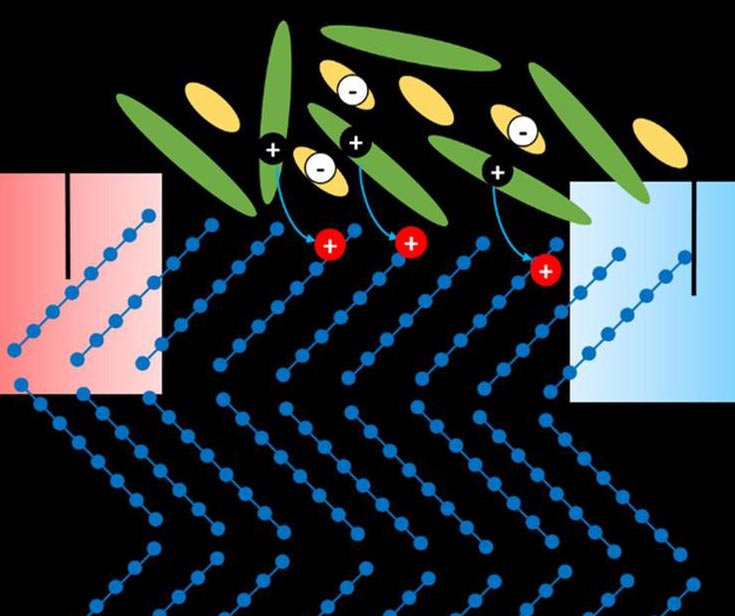
Transforming Body Heat Into Electricity: New Organic Thermoelectrics

Schematic illustration of the modulation doping process and thermal voltage generation.
Credit: Shu-Jen Wang
A step closer towards high-performance organic thermoelectrics.
Researchers from TU Dresden introduce a new path towards superior organic thermoelectric devices: highly efficient modulation doping of highly ordered organic semiconductors under high doping concentrations. The results have now been published in the renowned journal “Science Advances”.
Can you image charging your mobile phone by simply using your body heat? It may still sound rather futuristic, but thermoelectrics certainly can do. Thermoelectrics is all about transforming heat into useful energy, mostly using inorganic materials.
Because of their mechanical flexibility, light-weight and low thermal conductivity, organic semiconductors have emerged as a promising material system especially for flexible thermoelectric applications. Efficient doping for charge-carrier creation is the key in thermoelectric device performance. Conventional bulk doping typically introduces disorder at high doping concentration limiting the electrical conductivity. “In our study, we employed the modulation-doping approach to highly ordered organic thin films, where the dopant impurity is separated from the conduction channel. With this method, we are able to achieve highly efficient doping even at high doping densities without influencing the charge transport in the thin films,” explains first author Dr. Shu-Jen Wang from the Institute of Applied Physics at TU Dresden.
The team around Prof. Karl Leo investigated the charge and thermoelectric transport in modulation-doped large-area rubrene thin-film crystals with different crystal phases. They were able to show that modulation doping allows achieving superior doping efficiencies even for high doping densities, when conventional bulk doping runs into the reserve regime. Modulation-doped orthorhombic rubrene achieves much improved thermoelectric power factors. “Our results show that modulation doping together with high-mobility crystalline organic semiconductor films is a novel strategy for achieving high-performance organic thermoelectrics. The main advantage of the modulation doping technique is the avoidance of ionized impurity scattering in the highly ordered undoped narrow bandgap semiconductor allowing both carrier concentration and mobility to be independently maximized,” states Shu-Jen Wang and Prof. Karl Leo adds: “Our work paves new ways to achieve flexible thermoelectric devices which allow to directly generate electrical power from heat in an elegant way and efficient way. We believe our work will stimulate further work on high performance organic thermoelectrics using the modulation doping approach with high mobility organic semiconductors.”
Wissenschaftliche Ansprechpartner:
Dr. Shu-Jen Wang
Institute of Applied Physics (IAP)
TU Dresden
Email: shu-jen.wang@tu-dresden.de
Prof. Karl Leo
Institute of Applied Physics (IAP)
TU Dresden
Email: karl.leo@tu-dresden.de
Originalpublikation:
Shu-Jen Wang, Michel Panhans, Ilia Lashkov, Hans Kleemann, Federico Caglieris, David Becker-Koch, Jörn Vahland, Erjuan Guo, Shiyu Huang, Yulia Krupskaya, Yana Vaynzof, Bernd Büchner, Frank Ortmann and Karl Leo. “Highly efficient modulation doping: A path to-wards superior organic thermoelectric devices” Science Advances, DOI: 10.1126/sciadv.abl9264














